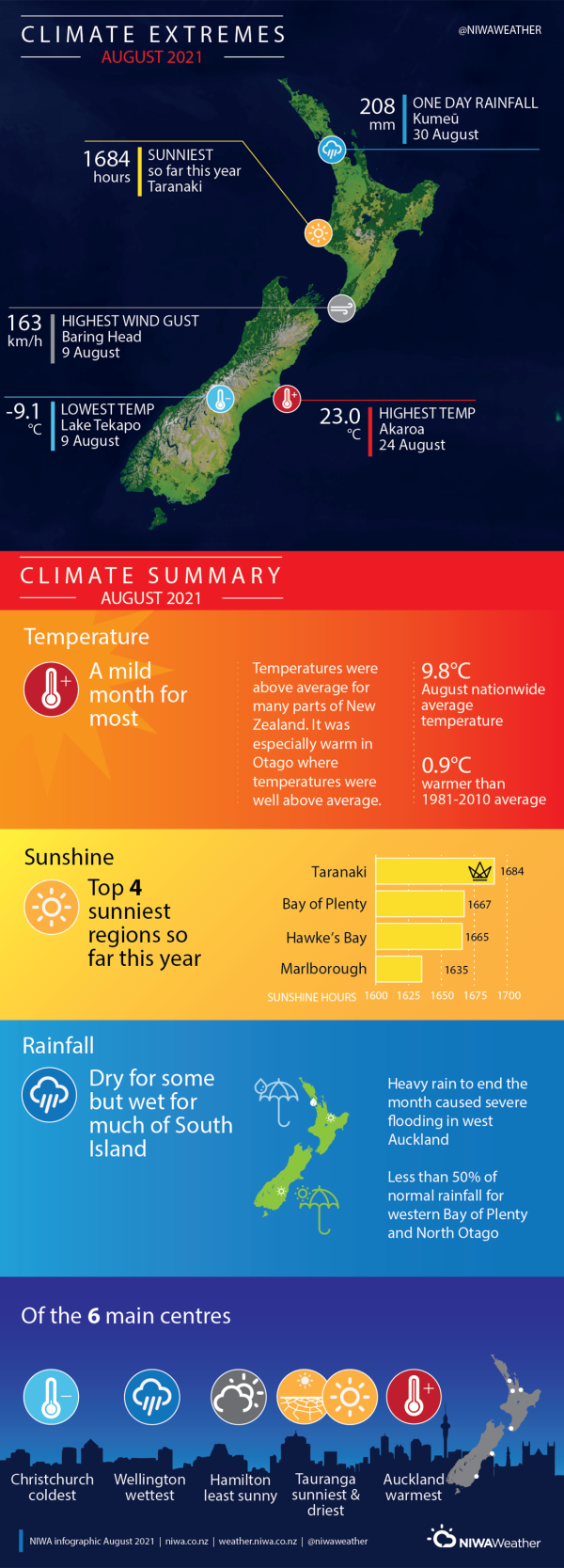A warm finish to winter for most of the country
|
Temperature |
Temperatures were above average (0.51°C to 1.20°C above average) or well above average (>1.20°C above average) for most of the South Island, Wellington, Whanganui, Taranaki, and parts of Waikato, Auckland, and Northland. Temperatures were near average (±0.50°C of average) for much of Bay of Plenty, southern Waikato, Gisborne, Hawke’s Bay, Wairarapa, the Kāpiti Coast, southern Marlborough, and coastal South Otago. Isolated areas of below average (0.51°C to 1.20°C below average) temperatures occurred in inland Bay of Plenty and western Gisborne District. |
|
Rainfall |
Rainfall was below normal (50-79% of normal) or well below normal (<50% of normal) in parts of Northland, Waikato, Bay of Plenty, Hawke’s Bay, coastal Canterbury south of Christchurch, and northern Otago. Rainfall was above normal (120-149% of normal) or well above normal (>149%) in southern and western Southland, inland Otago, coastal North Canterbury, Marlborough, Nelson, Tasman, Wellington, Wairarapa, Kāpiti Coast, coastal Manawatū-Whanganui, and parts of Auckland. |
|
Soil Moisture |
At the end of the month, soil moisture levels were lower than normal in eastern parts of Hawke’s Bay to the south of Napier. Soil moisture levels were higher than normal for eastern parts of North Canterbury and Marlborough, and parts of Auckland. Soil moisture levels were typically near normal for most remaining parts of New Zealand. |
Overview
August 2021 was characterised by higher than normal mean sea level pressure (MSLP) over the North Island and to the north of Aotearoa New Zealand, with lower than normal MSLP to the south of the country. This set up resulted in a northwest airflow anomaly (i.e. more northwesterly winds than normal). The prevailing northwest winds resulted in warmer than usual temperatures for many parts of New Zealand, but especially for the South Island. Overall, the nationwide average temperature in August 2021 was 9.8°C. This was 0.9°C above the 1981-2010 August average, making it New Zealand’s 9th-equal warmest August since NIWA’s seven station temperature series began in 1909.
Temperatures were well above average (>1.20°C above average) for most of Otago and eastern parts of Canterbury, with above average (0.51°C to 1.20°C above average) temperatures for most remaining parts of the South Island. Temperatures were also above average in parts of Wellington, Whanganui, Taranaki, northeastern Waikato, Auckland, and Northland. Temperatures were near average (±0.50°C of average) for much of Bay of Plenty, southern Waikato, Gisborne District, inland Hawke’s Bay, the Wairarapa, the Kāpiti Coast, southern Marlborough, and coastal South Otago. Below average (0.51°C to 1.20°C below average) temperatures occurred in isolated parts of inland Bay of Plenty and western Gisborne.
It was a dry finish to winter for parts of Northland, Waikato, Bay of Plenty, Hawke’s Bay, coastal Canterbury south of Christchurch, and northern Otago, where rainfall was mostly below normal (50% to 79% of normal). It was a particularly dry month in western Bay of Plenty and coastal North Otago, were well below normal (<50% of normal) rainfall was observed. In contrast, rainfall was above normal (120% to 149% of normal) or well above normal (>149% of normal) in southern and western Southland, inland Otago, coastal North Canterbury, Marlborough, Nelson, Tasman, Wellington, Wairarapa, Kāpiti Coast, coastal Manawatū-Whanganui, and parts of Auckland. Rainfall was typically near normal (80-119% of normal) for remaining parts of New Zealand. Several heavy rainfall events occurred during August, the most notable of which caused severe flooding in western parts of Auckland at the end of the month (see Highlights and extreme events section for further details).
Further highlights:
- The highest temperature was 23.0°C, observed at Akaroa and Orari Estate on 24 August.
- The lowest temperature was -9.1°C, observed at Lake Tekapo on 9 August.
- The highest 1-day rainfall was 208 mm, recorded at Kumeū (West Auckland) on 30 August.
- The highest wind gust was 163 km/h, observed at Baring Head on 9 August, and Cape Turnagain on 14 August.
- Of the six main centres in August 2021, Auckland was the warmest, Tauranga was the sunniest and driest, Christchurch was the coldest, Wellington was the wettest and Hamilton was the least sunny.
- Of the available, regularly reporting sunshine observation sites, the sunniest four regions in 2021 so far are Taranaki (1684 hours), Bay of Plenty (1667 hours), Hawke’s Bay (1665 hours), and Marlborough (1635 hours).


